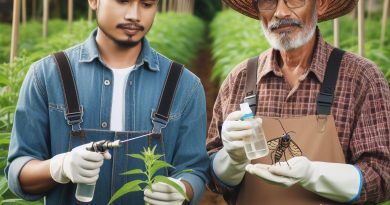Pest-Resistant Crops Explained
Last Updated on March 5, 2024
Introduction
Importance of pest-resistant crops in agriculture
Pest-resistant crops play a vital role in agricultural practices by protecting plants from harmful pests, mitigating the impact of pests on crop yields.
These genetically modified plants are engineered to express traits that deter or resist common pests, reducing the need for chemical pesticides.
This not only safeguards crop productivity but also minimizes environmental and health risks associated with pesticide use.
Pest-resistant crops contribute to sustainable farming practices, ensuring food security and economic stability for farmers.
Additionally, they promote resource efficiency, as fewer pesticides are required, leading to lower production costs.
Overall, the adoption of pest-resistant crops is vital for enhancing global food production and addressing challenges in modern agriculture.
Overview of the blog post content
Pest-resistant crops, a crucial facet of modern agriculture, are the focus of this blog post.
Delving into the world of agricultural innovation, the article explores the mechanisms behind these crops’ resistance to pests.
From genetic modifications to advanced breeding techniques, readers will gain insights into how scientists engineer plants to withstand insect attacks, minimizing the need for chemical pesticides.
The post also touches on the environmental and economic benefits of pest-resistant crops, addressing concerns and highlighting their potential to enhance global food security.
Whether you’re a farmer, a science enthusiast, or a consumer, this overview provides a concise understanding of the vital role pest-resistant crops play in sustainable agriculture.
This blog post provides an in-depth understanding of pest-resistant crops, including their benefits, genetic engineering techniques, and challenges.
What are pest-resistant crops?
In the previous chapter, we discussed the importance of pest-resistant crops in modern agriculture.
Now, let’s delve deeper into understanding what exactly these plants are, their purpose, and a few examples of popular pest-resistant crops.
Definition and Purpose
Pest-resistant crops, also known as genetically modified crops, are plants that have been genetically engineered to resist the harmful effects of pests and diseases.
These crops are created by introducing specific genes from other organisms, such as bacteria or viruses, into the genetic makeup of the plant.
The primary purpose of developing pest-resistant crops is to minimize crop losses due to pest infestations and reduce the need for synthetic pesticides.
By incorporating pest-resistant traits, farmers can protect their plants from pests without relying heavily on chemical insecticides, which can have harmful effects on both the environment and human health.
Examples of Pest-Resistant Crops
1. Bt Cotton
One of the most well-known pest-resistant crops is Bt cotton. Bt stands for Bacillus thuringiensis, a naturally occurring soil bacterium that produces a protein toxic to certain pests, particularly cotton bollworm.
The Bt gene is inserted into cotton plants, enabling them to produce this protein, making them toxic to the pest and hence, resistant to its attacks.
Bt cotton has revolutionized cotton farming by reducing the need for spraying insecticides and increasing the yield significantly, benefitting farmers worldwide.
2. Bt Corn
Similar to Bt cotton, Bt corn also contains the Bacillus thuringiensis gene. This gene allows the corn plant to produce specific proteins that are toxic to certain pests, such as the European corn borer and corn rootworm.
By incorporating the Bt trait, farmers can protect their corn crops from pest damage, resulting in higher yields and reduced reliance on chemical insecticides. Bt corn has become a popular choice among corn farmers globally.
3. Herbicide-Tolerant Soybeans
Another example of pest-resistant crops is herbicide-tolerant soybeans. These genetically modified soybeans are designed to withstand the application of specific herbicides, such as glyphosate.
When herbicides are sprayed, they kill the weeds while leaving the herbicide-tolerant soybean plants unharmed. This allows farmers to effectively control weed growth without causing harm to their soybean crops.
In addition to reducing the need for manual weed control, herbicide-tolerant soybeans offer other benefits, such as improved crop quality and increased yield potential.
In fact, Pest-resistant crops have revolutionized modern agriculture by providing an effective and sustainable solution to pest management.
By incorporating specific genes into their genetic makeup, these crops can resist pests and diseases, reducing crop losses and minimizing the use of harmful chemicals.
Bt cotton, Bt corn, and herbicide-tolerant soybeans are just a few examples of the many pest-resistant crops available today.
These crops have not only benefited farmers but also contributed to enhanced food production and environmental sustainability.
In the next section, we will delve further into the potential advantages and concerns surrounding the cultivation of pest-resistant crops. Stay tuned!
Read: Mastering Soil pH: A Guide for Growers
Benefits of pest-resistant crops
Reduced use of chemical pesticides
Pest-resistant crops offer numerous benefits that contribute to a sustainable and efficient agricultural system.
One of the most significant advantages is the reduced use of chemical pesticides, which has positive implications for both human health and the environment.
Traditional farming methods often rely heavily on these harmful chemicals to control pests and diseases.
However, with the introduction of pest-resistant crops, farmers have the opportunity to minimize their dependence on chemical pesticides.
By cultivating pest-resistant crops, farmers can target specific pests that pose a threat to their plants.
These genetically modified organisms (GMOs) are designed to produce toxins that are harmful only to the targeted pests.
As a result, farmers can avoid using broad-spectrum pesticides, which are more detrimental to non-target organisms and can lead to ecological imbalances.
The reduced use of chemical pesticides not only benefits the environment but also promotes human health.
Pesticides have been linked to various health issues, including respiratory problems, cancer, and reproductive disorders.
By decreasing the reliance on these harmful chemicals, pest-resistant crops contribute to safer farming practices and healthier food production.
Increased crop yields
Another major advantage of pest-resistant crops is the potential for increased crop yields. Pests and diseases can cause significant damage to crops, leading to reduced productivity and economic losses for farmers.
With the incorporation of genetic modifications that make crops resistant to pests, farmers can protect their harvests and achieve higher yields.
Pest-resistant crops are engineered to express certain traits that deter pests or make the plants less prone to diseases.
These genetic modifications enhance the plants’ ability to defend themselves, leading to healthier and more robust crops.
In turn, farmers can harvest larger quantities of high-quality produce, meeting the increasing demand for food in a growing global population.
Lower production costs
The use of pest-resistant crops can also result in lower production costs for farmers. Traditional pest control methods, such as the spraying of chemical pesticides, can be expensive.
These pesticides are costly, and their repeated application throughout the growing season adds up to a significant financial burden.
By adopting pest-resistant crops, farmers can reduce their reliance on chemical pesticides, which translates into lower input costs.
Additionally, pest-resistant crops may require fewer applications of other agricultural inputs, such as fertilizers, as they are less susceptible to damage from pests and diseases.
These cost savings contribute to improved profitability and financial stability for farmers.
Environmental sustainability
Last but not least, pest-resistant crops play a vital role in promoting environmental sustainability. The reduced use of chemical pesticides helps preserve biodiversity and protect ecosystems.
Pesticides, particularly those with broad-spectrum effects, can harm beneficial insects, birds, and other organisms that contribute to natural pest control.
By embracing pest-resistant crops, farmers can support sustainable agriculture practices that minimize the negative impact on the environment.
These crops enable a more targeted approach to pest management, reducing pesticide residues in the soil, water, and air.
As a result, the overall ecological balance is maintained, ensuring a healthier and more sustainable agricultural system.
In general, pest-resistant crops offer numerous benefits that contribute to a more sustainable and efficient agriculture.
By reducing the use of chemical pesticides, farmers can promote human health, protect the environment, and save on production costs.
Moreover, these crops can lead to increased crop yields, helping meet the demand for food in a growing global population.
With their many advantages, pest-resistant crops are a promising solution to the challenges faced by modern agriculture.
Read: Mastering Soil pH: A Guide for Growers
Mechanisms of pest-resistance
Achieving pest-resistance in crops can be accomplished through various mechanisms. Some of the common methods include:
Genetic modifications
- Genetic modifications involve altering the genetic makeup of crops to enhance their ability to resist pests.
- This can be done through techniques like gene editing or genetic engineering.
- By introducing specific genes into the crop’s DNA, scientists can enhance its natural defense mechanisms.
- Genetic modifications allow crops to produce toxins or compounds that deter pests.
- These modifications can also make the crops more resilient against diseases transmitted by pests.
Introduction of foreign genes
- Another approach to creating pest-resistant crops is by introducing genes from other species.
- This involves identifying genes from pests or other plants that contribute to pest resistance.
- These genes can then be incorporated into the crop to enhance its defenses against pests.
- By importing genes from pest-resistant plants, crops can acquire their natural pest resistance traits.
- This method allows for a broader range of defenses against pests, making crops more resilient in diverse environments.
Activation/inhibition of natural defense mechanisms
- Instead of modifying the genetic makeup, another strategy is to activate or inhibit natural defense mechanisms in the crop.
- Plants have their own defense mechanisms against pests, such as producing toxic compounds or activating immune responses.
- Scientists can identify ways to stimulate these defense mechanisms to enhance the crop’s ability to resist pests.
- On the other hand, inhibiting certain defense mechanisms can also reduce susceptibility to pests.
- By manipulating the natural defense mechanisms, crops can effectively ward off pests without genetic modifications.
The mechanisms of pest-resistance in crops are a critical area of research and development in agriculture.
Through genetic modifications, introduction of foreign genes, and activation/inhibition of natural defense mechanisms, scientists and farmers can produce crops that are more resistant to pests.
These pest-resistant crops offer numerous benefits, such as reduced pesticide use, increased yield, and improved food security.
However, it is important to ensure that the development and deployment of these crops are done responsibly:
- Proper risk assessments must be conducted to evaluate the potential environmental and health effects.
- Regulatory frameworks should be in place to address any concerns related to the use of genetically modified organisms.
- Farmers must also receive adequate training and support to effectively utilize pest-resistant crops.
By harnessing these mechanisms of pest-resistance, agriculture can become more sustainable and resilient in the face of pests and diseases.
Read: Organic vs Chemical Fertilizers: A Comparison

Gain More Insights: Natural Pest Control in Farming
Challenges and Concerns with Pest-Resistant Crops
While the development of pest-resistant crops has brought many benefits, it also poses several challenges and concerns that need to be addressed. These challenges include:
Resistance Development in Pests
One of the main concerns with pest-resistant crops is the potential development of resistance in pests.
When crops are engineered to be resistant to specific pests, there is a risk that these pests will eventually evolve and develop resistance to the crops’ defenses.
This can result in the emergence of “super pests” that are unaffected by the pest-resistant traits of the crops.
This would then require the development of new strategies and technologies to combat these resistant pests.
Unintended Harm to Beneficial Organisms
Another challenge is the potential unintended harm that pest-resistant crops can cause to beneficial organisms.
While these crops are designed to target specific pests, they may also affect non-target organisms, such as pollinators and natural predators of pests.
For example, genetically modified crops that produce toxins harmful to certain insect pests may also harm beneficial insects like bees, butterflies, and ladybugs.
This can disrupt ecosystem balance and have unintended consequences for crop pollination and pest control.
Potential Impact on Biodiversity
The widespread adoption of pest-resistant crops has raised concerns about its potential impact on biodiversity.
The introduction of genetically modified crops and the extensive use of pesticides associated with these crops can lead to a reduction in the diversity of plant and animal species in agricultural landscapes.
This loss of biodiversity can disrupt ecosystems, leading to the decline of species that are important for maintaining ecological balance.
It can also affect the long-term sustainability of agriculture by reducing resilience to environmental changes and increasing vulnerability to pest outbreaks.
Ethical and Social Aspects
There are also ethical and social concerns associated with pest-resistant plants. Some people argue that the use of genetically modified crops and associated pesticides may have negative impacts on human health and the environment.
There are concerns about the potential long-term effects of exposure to genetically modified organisms and pesticides on human health.
Additionally, the use of genetically modified crops raises questions about the ownership and control of agricultural resources, as well as the rights of farmers to save and exchange seeds.
Furthermore, the adoption of pest-resistant plants may have social implications, particularly for farmers in developing countries.
These farmers may become dependent on large seed and pesticide companies, leading to issues of economic inequality and loss of traditional farming practices.
In all, while pest-resistant plants offer many potential benefits, they also pose challenges and concerns that need to be carefully considered and addressed.
The development of resistance in pests, unintended harm to beneficial organisms, potential impacts on biodiversity, and ethical and social aspects all require attention to ensure the long-term sustainability and responsible use of these crops.
Read: Safe Use of Chemical Fertilizers in Farms
See Related Content: The Role of Compost in Soil Health
Discover More: Effective IPM for Common Crop Pests
Current and future developments
Pest-resistant crops are an important solution to combat agricultural pests and ensure food security.
The development and implementation of these crops have evolved over time, with ongoing research and advancements in technology. In this section, we will explore the current and future developments in pest-resistant plants.
New technologies and genetic engineering
Genetic engineering plays a significant role in developing pest-resistant plants. Scientists have been able to insert genes from various sources into crop plants, providing them with built-in protection against specific pests.
This technology has revolutionized crop breeding and allowed for the creation of crops that are resistant to a wide range of pests.
One example of this is the introduction of the Bacillus thuringiensis (Bt) gene into crops such as corn and cotton.
The Bt gene produces a toxin that is lethal to certain pests, such as the European corn borer or cotton bollworm.
By integrating this gene into the crops, farmers can effectively control these pests without the need for chemical pesticides.
Genetic engineering also allows for the development of crops with enhanced resistance traits. Scientists can identify genes that provide natural resistance to pests and transfer them into crop plants.
This process enables the crops to withstand multiple pest attacks, reducing the need for additional pest control measures.
Integration of multiple resistance traits
Another important development in pest-resistant crops is the integration of multiple resistance traits.
Rather than relying on a single gene or technology, scientists are working on developing crops with a combination of resistance traits to combat a wider range of pests.
This approach involves stacking different genes that provide resistance to various pests or combine different modes of action to enhance resistance.
By combining multiple resistance traits, crops become more resilient to pests and minimize the risk of pest outbreaks.
For instance, a crop might possess genes for resistance to both insects and diseases.
This integrated approach offers farmers a comprehensive and sustainable solution to manage pests effectively while reducing the dependency on chemical pesticides.
Sustainable pest management practices
In addition to technological advancements, sustainable pest management practices are gaining prominence in the development of pest-resistant crops.
These practices aim to reduce the reliance on chemical pesticides, minimize environmental impacts, and preserve natural pest control mechanisms.
Integrated Pest Management (IPM) is a key strategy that promotes holistic pest control.
It combines various pest control techniques, such as cultural practices, biological control, and judicious use of pesticides.
By adopting IPM, farmers can effectively manage pests while minimizing the negative effects on the environment and human health.
Furthermore, crop diversity and rotation can contribute to sustainable pest management.
Planting a variety of crops and rotating their cultivation can disrupt pest life cycles, reduce the build-up of pest populations, and improve overall crop health.
This approach ensures that pests are less likely to develop resistance to specific control measures.
The future of pest-resistant crops holds great promise.
Advancements in genetic engineering, the integration of multiple resistance traits, and the promotion of sustainable pest management practices will continue to enhance the effectiveness and sustainability of pest-resistant crops.
These developments will not only benefit farmers but also contribute to global food security and environmental conservation.
Gain More Insights: Chemical Fertilizers: Understanding Risks
Conclusion
Pest-resistant crops are vital and offer numerous benefits to the agricultural industry.
They play a crucial role in global agriculture by minimizing yield losses and reducing the need for chemical pesticides.
Engineered to withstand attacks from insects and pests, these crops enhance food security, ensuring stable harvests despite environmental challenges.
By mitigating the use of chemical agents, they contribute to sustainable farming practices, preserving soil health and biodiversity.
Additionally, pest-resistant crops offer economic advantages, as farmers experience higher yields and lower production costs.
Overall, the adoption of these genetically modified crops represents a significant step towards achieving a more resilient and efficient agricultural system to meet the growing demands of a burgeoning global population.
Further research and adoption of these crops should be encouraged to enhance sustainability and productivity.


